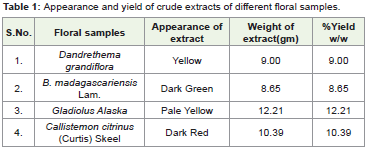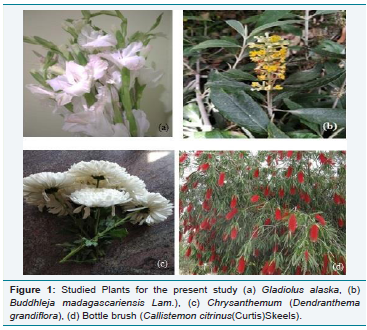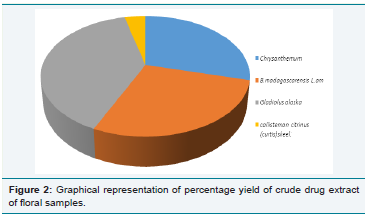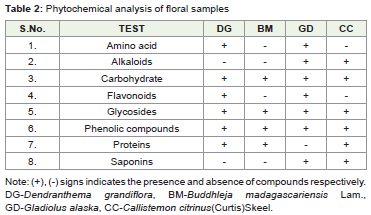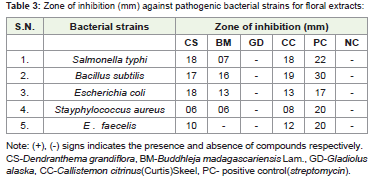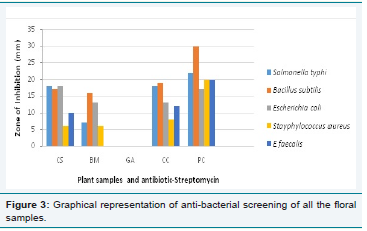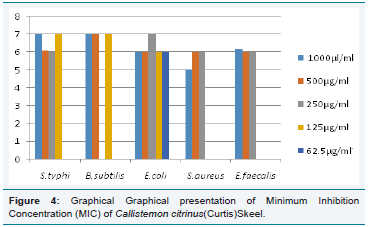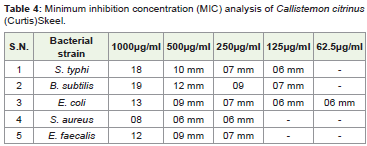Research Article
Evaluation of Phytochemical and Antibacterial Activity of Floral Extract of Winter Season Plants in Uttarakhand, India
Singh M1*, Negi R2, Maithani A2, Kumari N2 and Kumar R3
1School of Agricultural Sciences, Shri Guru Ram Rai University, India
2School of Basic and Applied Sciences, Shri Guru Ram Rai University, India
3Department of Horticulture and Food Processing, Uttarakhand, India
*Corresponding author: Singh M, Associate Professor, School of Agricultural Sciences, Shri Guru Ram Rai University, Pathri Bagh, Dehradun (248001), Uttarakhand, India, Tel: 0135-2721763; Email:
singhmaneesha2@gmail.com
Copyright: © Singh M, et al. 2020. This is an open access article distributed under the Creative Commons Attribution License, which permits unrestricted use, distribution, and reproduction in any medium, provided the original work is properly cited.
Article Information: Submission: 07/08/2020; Accepted: 10/09/2020; Published: 14/09/2020
Abstract
Many plants used today were well known to the people of ancient cultures throughout the world and they were valued for their preservation and
medicinal powers. Similarly, Flowers are an essential part of our life, and are wonderful gift of nature, act as a refresher and soothing agents. They
are used in Naturopathy and Aromatherapy. The present study deals with the extraction of crude drug from floral samples of four different genera i.e., Buddhleja madagascariensis Lam., Dendranthema grandiflora, Gladiolus alaska, Callistemon citrinus(Curtis) Skeel for evaluation of phytochemical
and antibacterial activity. Phytochemical screening of these extracts showed the presence of alkaloids, carbohydrates, flavonoids, protein and phenolic
compounds while absence of saponin, amino acids in some of samples. Antimicrobial activity studies revealed that Callistemon citrinus(Curtis)Skeel plant
extract had maximum activity against all the studied bacterial strains. Therefore, Minimum Inhibition Concentration (MIC) of Callistemon citrinus(Curtis)
Skeel was determined which showed maximum MIC value against B. subtilis followed by S. typii. On the basis of present studies, it was concluded that
plants not having only ornamental values but they can be used for extraction of phytochemicals like alkaloids, flavonoids and phenolic which can be used
as antioxidants and antibacterial agents. Thus, in near future these floral extract may be use for the welfare of mankind.
Keywords
Antimicrobial activity; Minimum Inhibitory Concentration; Phytochemicals
Introduction
Plants are accustomed treat a large range of diseases throughout
the history of citizenry and this practice continues to this point.
Despite the event and growth in conventional medicine, WHO
reported that 80% of the Third World population still depend on
medicinal plants because the answer to their health problems. This
is mainly because most of those herbals are available, affordable
and have little or no side effects [1,2]. Phytochemical investigation
has proved that indeed plants posses a large range of secondary
metabolites, many of which are bioactive against various pathogens,
while other compounds have disease preventive properties. Still,
others are important in food preservation, as alternative and natural
medicine [3]. Drugs derived from plants could also be utilized
in their crude form or as semi-synthetic derivatives that manage
various ailments. Some naturally medicinal compounds include,
ephedrine (bronchodilator), colchicines (antigout), morphine
(analgesic) and artemisinin (antimalarial) among others [4]. The
anti-microbial properties of plants are investigated by number of
researchers worldwide [5,6]. Since antiquity, plants are accustomed treat common infectious diseases, the healing potential of the many
plants are utilized in Indian traditional medicines like Siddha,
Ayurveda and Unani medicine [7]. The rising prevalence of microorganism
showing resistance to antibiotics, there’s an urgency
to develop new antimicrobial compounds. Infectious diseases
represent a very important reason behind morbidity and mortality
among the final population, particularly in developing countries.
Therefore, pharmaceutical companies are motivated to develop
new anti-microbial drugs in recent years, especially because of the
constant emergence of microorganisms proof against conventional
antimicrobials. Apparently, bacterial species present the genetic
ability to amass and transmit resistance against currently available
anti bacterial since there are frequent reports on the isolation of
bacteria that are known to be sensitive to routinely used drugs and
have become multi proof against other medications available on the
market [8]. Extracts from the dried flowers and leaves of plants are
applied as a paste on wounds in some rural communities. The fresh
juice of flowers for e.g. Catharanthus roseus was being added within
the preparation of tea and also been employed by ayurvedic physicians
in India for external use to treat skin problems like eczema and acne
[9]. Chrysanthemum plants, other than their ornamental value,
are highly aromatic because of many volatile components of their
essential oils, many of which are utilized in the flavour and fragrance
industries. Flower heads are mainly used as chamomile adulterants.
While in Japan the leaves are used for suppression of fishy odour in
foods like Japanese style soup, yuzu or in Japanese pepper. Buddhleja species are one amongst the important genus of figwort family. It’s been used for skin complaints [10] and as abortilacient. A fusion of
roots is employed within the treatment of malaria. Gladioli are flowery plants of great economic importance and are mainly cultivated for ornamental and floricultural purposes [11,12]. In some species of Gladioli have various ethnomedical uses like within the treatment of a spread of diseases including hypertension [13]. Gladiolus dalenii is employed to treat gonorrhoea, earache, wounds and disease among others [14]. Callistemon citrinus (Curtis) Skeel is very important member of Myrtaceae family commonly referred to as bottlebrush
because of the looks of their flowers. Callistemon flowers were used as a food source by Australian Arborigines. The flowers were sucked for his or her nectar or accustomed make sweet drink [15].
On the basis of literature and above mentioned survey, it was
essential to find out new sources of antimicrobial drugs which
can be procured easily without having their side effects and have
high economic potential. In this regards, present studies deal with
extraction of crude drugs from commonly available floral parts, their
preliminary phytochemical potential and antibacterial activity in
Uttarakhand, India for treatment of manifestation caused by several
pathogenic bacteria.
Materials and Methods
Location of the Experiment and Climatic Conditions:
The present investigation was carried out at Biotechnology
laboratory, School of Basic and Applied Sciences, Patel Nagar,
Dehradun, Uttarakhand located at 30.31650 N(latitude), 78.03220 E
(longitude). Located amongst shivalik ranges on the Foothills of
the Himalayas, the Doon Valley is nestled between two of Indias’ mightiest rivers the Ganga on the east and Yamuna on the west. The
climate of Dehradun is generally temperate, although it varies from
tropical, to several cold, depending upon the season, and the altitude
of area. The nearby hill regions often get snowfalls during winter but
the temperature in Dehradun does not go under 00. During summer
the temperature here is usually between 27-400C where as during
winter it is between 2-240C. During monsoon there often constant
and heavy rain falls. The main synclinal through receive an average
of 210 cm rainfall annually. The agriculture is good here due to the
fertile alluvial soil and the adequate water drainage and rainfall.Material:
The material for the present studies comprises of the plant Smoke bush (Buddhleja madagacarensis Lam.), Chrysanthemum(Dendranthema grandiflora), Gladiola (Gladiolus alaska), Bottle
brush (Callistemon citrinus(Curtis) Skeels).Experiment Methodology:
Collection and extraction of crude plant drug:The fresh floral parts of present studied plants were collected
from different places of Dehradun, Uttarakhand. About 100gm
accurately weighed fresh flower plant samples were soaked in ethanol
for 72 hours at 260C. The ethanolic extract were transferred in round
bottom flask, leave it for heating at 600C for 2 hours. The concentrated
extract was transferred to the weighed air tight containers and stored
in the refrigerator for further screening of phytoconstituents and
antimicrobial activity.
Percentage yield:
Percentage yield of the crude extract were calculated with the
formula:Percentage yield =weight of extract /weight of powdered drug taken X 100
Phyto-chemical analysis:
The crude floral extract of flowers of studied plants was subjected to preliminary qualitative phytochemical investigation. The various test such as alkaloids (Dragendorff’s reagent), proteins (Biuret test), carbohydrates (Molisch’s test), flavonoids (Lead acetate test), glycosides, amino acids (Ninhydrin test), phenolic compounds
(FeCl3 solution), saponins (Foam test) were conducted to determine the presence or absence of the phyto constituents on the basis of colour changes [16].Sources of bacterial culture:
Five pathogenic bacterial strains i.e. two Gram positive-
Staphylococcus aureus MTCC-737, Bacillus subtilis, and three
Gram negative bacteria-Escherichia coli ATCC-433, Pseudomonas aeruginosa ATCC-424 and Salmonella typhi MTCC-1255 were
procured from Shri Guru Ram Rai University, Patel Nagar, Dehradun,
Uttrakhand to evaluate antibacterial potential of the floral extracts of
different flowers. These bacterial strains were preserved in nutrient
agar at 40C, revived in nutrient broth (liquid medium) and incubated
at 37 oC for 24 hours.Anti-bacterial assay procedure:
The anti-bacterial assay performed by the disc diffusion method
using pre sterilised disc made from whatman filter paper of diameter
6 mm [17]. The disc diffusion method tests the effectiveness of
antibiotics on some specific microorganisms. A pure colony of each
of the test bacterial strains were sub cultured into 5mL of nutrient
broth using inoculating loop followed by incubation at 37ºC for
12 hours. The dried extracts were dissolved in dimethyl sulfoxide
(DMSO) and subjected to preliminary antibacterial screening with
the concentration of 1000 μg/ml to know whether they were active
against the particular bacteria or not. 0.1mL of inoculums was spread
on the solidified Muller Hinton agar surface. For screening of active
extracts, sterile 6mm diameter what man No. 41 filter paper discs
were dipped in the plant extracts and then placed carefully onto the
Muller Hinton agar media against the studied bacterial strains. The
results were recorded by measuring the zones of growth inhibition
surrounding the disc. Clear inhibition zones around the discs indicate
antibacterial activity.
Minimum inhibition concentration (MIC) is the lowest
concentration of an antimicrobial drug that will inhibit the visible
growth of microorganisms after overnight incubation. In the present
experiments, the MIC value of extracts were determined only
against those bacterial strains which showed high activity during
the preliminary anti-bacterial testing, MIC analysis was performed
by serial dilutions of the active concentrated plant extracts in pure
DMSO to achieve the decreasing concentration range of 1000μg/ml
to 31.25μg/ml. By using different concentration of plant extracts i.e.
the zone of inhibition around the discs the lowest concentration of
which the bacterial strains were susceptible would be determined as
MIC of the plant extracts against the particular bacterial strains. The
sensitivities of all the bacterial strains were also observed against the
standard drugs such as Streptomycin (15mcg) and against DMSO to
set them as a positive and a negative control, respectively.
Result and Discussion
Plants have been used for thousands of years to flavour and conserve food, to treat health disorders and to prevent diseases including epidemics. The knowledge of their healing properties has been transmitted over the centuries within and among human communities. Active compounds produced during secondary vegetal
metabolism are usually responsible for the biological properties of some plant species used throughout the globe for various purposes, including treatment of infectious diseases. Currently, data on the antimicrobial activity of numerous plants, so far considered empirical have been scientifically confirmed concomitantly with the increasing number of pathogenic microorganism resistant to antimicrobials. Products derived from plants may potentially control microbial growth in diverse situations and in the specific case of disease treatment [18]. Flowers are wonderful gift of nature act as a refresher and soothing agents used in naturopathy and aromapathy. Most of anti microbial studies were concentrated on extraction of crude drugs from the vegetative parts of the plants. Studies on floral extract used for antimicrobial activities are very limited. The experimental
methodology has been adopted to the present study includes ethanol extraction, concentration of the extracts followed by preliminary phytochemical characterization, anti-bacterial screening against pathogenic bacterial strains and the determination of the MIC value of the active floral extracts against pathogenic bacteria strain. The findings of the present studies were as follows:
Appearance and Yield of Crude Extract::
The appearance of ethanolic crude extract from four different floral samples varied from pale yellow to dark green to red (Table 1). Percentage crude extracts range from 12.21% (Gladiolus alaska) to 8.65% (B. madagascariensis Lam.). Maximum yield was obtained by Gladiolus alaska (12.21%) followed by Callistemon citrinus(Curtis) Skeel (10.39%) (Figures 1,2).
Figure 1: Studied Plants for the present study (a) Gladiolus alaska, (b)
Buddhleja madagascariensis Lam.), (c) Chrysanthemum(Dendranthema
grandiflora), (d) Bottle brush (Callistemon citrinus(Curtis)Skeels).
Preliminary Phytochemical Screening:
The term phytochemical is generally used to refer to those chemicals which are derived from the plants source. Alkaloids, tannins, flavonoids, saponin, glycoside, terpenoids, steroids etc. are some classes of phytochemicals [19,20]. They play different role in various biological activities like anti-cancer, anti-antioxidant, antiinflammatory
activities etc [21].On the basis of present studies on preliminary phytochemical characterization of the floral extract revealed the presence of carbohydrates, glycosides, phenolic compounds in all the samples (Table 2). Amino acid and flavonoids were present in Dendranthema grandiflora and Gladiolus alaska but absent in Buddhleja madagascariensis Lam and Callistemon citrinus(Curtis) Skeel. Alkaloids and saponins were present in Gladiolus alaska and Callistemon citrinus(Curtis)Skeel but absent in Dendranthema grandiflora and Buddhleja madagascariensis Lam. Similarly, the member of Iridaceae family includes flavonoids glycosides, triterpenoids in which flavonoids and their glycosides are found predominantly. Phytochemical screening was also performed on one of Buddhleja species i.e. Buddhleja polystachya was rich in flavonoids, alkaloids, terpenoides, cardiac glycosides, oils and saponin compounds [22].
Anti-Bacterial Test:
Different extracts of floral samples showed anti bacterial activity against all the bacterial strains that are highly pathogenic to human beings causing several diseases such as food poisoning, urinary tract infection, pneumonia, fever etc [14]. Ethanol extracts of floral samples were tested at 1000μg/ml concentration against two gram negative and three gram positive bacterial strains (Table 3, Figure 3). Antibacterial activity of any sample can be determined by calculating the zone of inhibition. Among the studied floral extract samples, zone of inhibition varied from 6 mm in Stayphylococcus aureus to 30 mm in Bacillus subtilis, in Dendranthema grandiflora zone of inhibition varied from 6mm in Stayphylococcus aureus to 18mm in E. coli and S. typhi. In Buddhleja madagascariensis Lam., zone of inhibition ranges from 6 mm in Stayphylococcus aureus to 16 mm in Bacillus subtilis. Whereas no zone of inhibition was reported against the floral sample of Gladiolus alaska. Among the extract assayed, one extract Callistemon citrinus(Curtis)Skeel was found to be most active against most of the studied bacterial strains followed by Dendranthema grandiflora. The activity against both gram positive and gram negative type of bacteria may be indicative of the presence of broad spectrum antibiotic compounds or, simply metabolic toxins [23].Similar studies were reported on antibacterial activity of Callistemon citrinus(Curtis)Skeel leaves against human pathogens and on Buddhleja asiatica against B. subtilis, S. aureus, P. aeruginosa,
E. coli [24,25]. Anti bacterial activity of Chrysanthemum(leaves,
flower, stem, roots) was reported against 14 bacteria and showed
some degree of activity against one or more microbial strains [26].
The ready to use antibiotic impregnated disc streptomycin was used
as a positive control in order to check the activity of the pathogenic
bacterial strains. It showed clear zones of inhibition around the disc
interpreting their high activity towards antibiotics. In contrast to
this, DMSO (99% pure) was used as a negative control. There was no
activity of DMSO against bacterial strains.
Minimum Inhibitory Concentration (MIC) Analysis:
Minimum Inhibitory concentration (MIC) is important in
diagnostic laboratories to confirms resistance of microorganism to
an antimicrobial agent and also to monitor the activity of new anti
microbial agents, A lower MIC is an indication of better antimicrobial
agent [27,28].MIC was performed by serial dilution of the concentrated crude
extract of Callistemon citrinus(Curtis)Skeel in pure DMSO to achieve
a decreasing concentration range of 1000 μg/ml to 62.5 μg/ml (Table 4) (Figure 4). MIC activity reported with 62.5μg/ml for B. megaterium
and E. coli that showed potential efficacy against the bacteria for
Callistemon citrinus(Curtis)Skeel. Out of five studied bacterial strains,
maximum MIC value was reported by B. subtilis followed by S. typii.
Minimum MIC value was reported by S. auerus.
Figure 4: Graphical Graphical presentation of Minimum Inhibition Concentration (MIC) of Callistemon citrinus(Curtis)Skeel.
Conclusion
On the basis of present study on evaluation of phytochemical screening of the crude extracts showed the presence of secondary metabolites such as alkaloids, flavonoids, carbohydrates, proteins and phenolic compounds in all the studied floral extract and MIC of Callistemon citrinus possess good antibacterial activity. This study suggested that plants not having only ornamental values but they can be used for extraction of phytochemicals like alkaloids, flavonoids and phenol which can be used as antioxidants and antibacterial
agents. Thus, in near future the floral extract of these plants may be use for various biological activities for the welfare of mankind.

